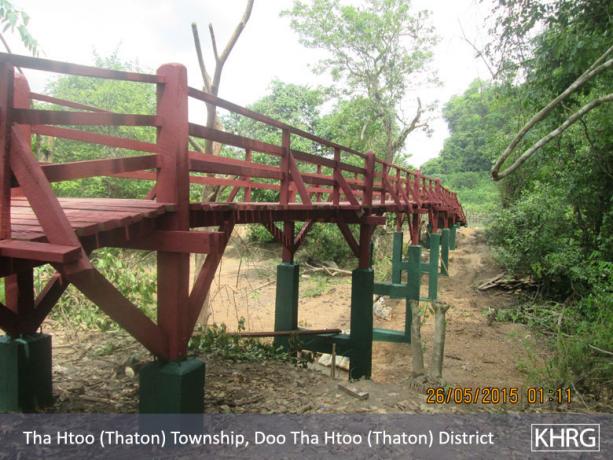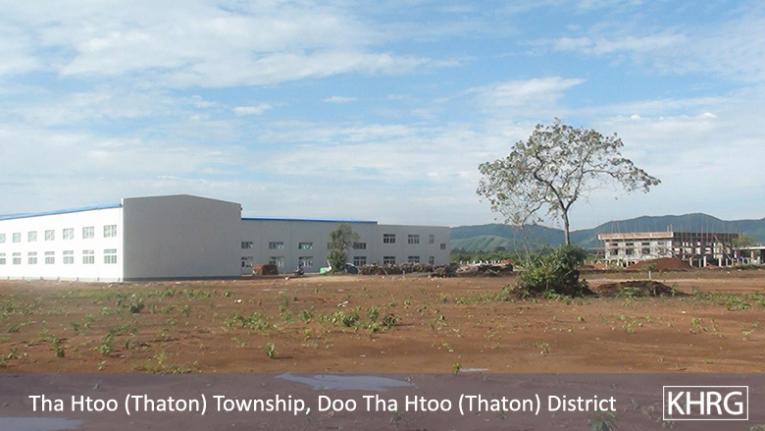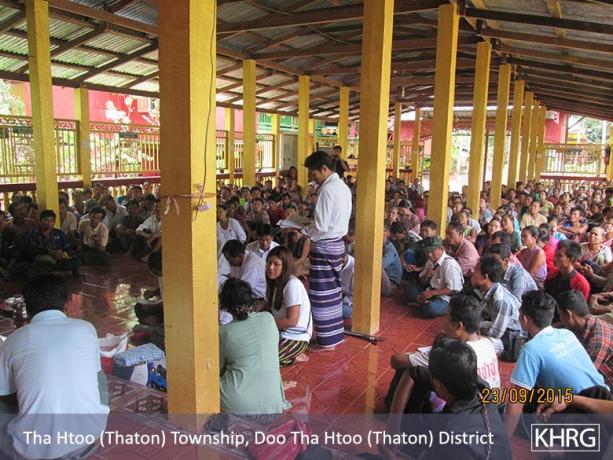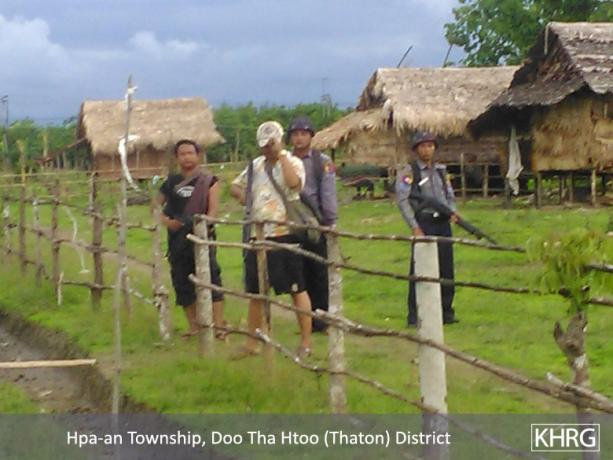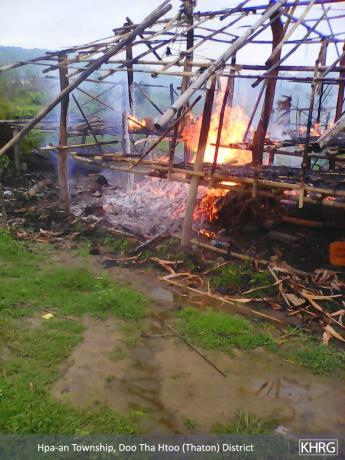This Field Report describes events occurring in Thaton District between January and December 2015. It includes information submitted by KHRG community members on a range of human rights violations and other issues important to the local community including: the Myanmar 2015 general election, ceasefire concerns and military situation, community development and for-profit development, health and education, forced relocation and land confiscation.
- Regarding the 2015 general election, local villagers across Thaton District complained of disappointment about representative parties for not holding proper education in their constituency during the campaign period. Villagers did not understand how to vote and where to vote. In addition, local people who did not have an ID card were not allow to vote but also some people who were eligible to vote were excluded from the voting list.
- In terms of health and education, although the Myanmar government itself as well as NGOs built clinics and provided medication in local communities, health care service overall is still poor across Thaton District. Likewise, there are various kinds of schools and types of teachers in Thaton District and some students in rural areas quit their education after they finished primary school.
- During the 2015 reporting period, KHRG received information about ongoing land confiscation and forced relocation in the research areas, and the impact this was having on local people.
Myanmar 2015 general election
Amongst the received information during the 2015 documentation period from KHRG field researchers, they reported about how the Myanmar 2015 general election campaign was conducted. Many political parties including previously unknown small parties conducted the election campaign all over the country. In Thaton District, which is one of the seven KHRG research areas, local villagers raised their perspective and feeling as they experienced how the campaigns were conducted.
In Hpa-an Township, well-known political parties such as National League for Democracy (NLD), Karen People’s Party (KPP) and Union Solidarity and Development Party (USDP) also known as U Thein Sein’s [former president of Myanmar] party competitively conducted the campaign in the area of their constituency. Each party held the campaign differently according to their own method.
Regarding the election campaign, one of the common experiences that local civilians in Hpa-an Township and Bilin Township complained about was how each party did not give out proper information about the voting system. Thus, some villagers did not understand about the voting system or how to vote. Some villagers who do not have ID were not allow to vote and also some villagers who were eligible to vote reported that they were left off the voting list. In addition, civilians from mountainous areas were not given a choice about the parties that they wanted to vote for due to no campaigns entering into their area. Likewise, some villagers had concerns that the incumbent government [USDP] would continue to take control of power even if NLD won the election.[1]
In Kyeh Htoh [Kyaikto] Township, as villages are under Myanmar government control and located close to the main highway road, there was easy to access for representative parties to hold election campaigns, and most of the village could give a vote. The villagers were advocated to and the representative parties also distributed a CD about the election in order to let them know the process of how to vote and where to vote. However, some villagers were still excluded from the voting list although they had national ID card.[2]
Ceasefire concerns and military situation
Based on the information received, military groups including Tatmadaw, Karen ethnic armed organisations (EAOs) such as Karen National Union (KNU), Karen National Liberation Army (KNLA), Democratic Karen Benevolent Army (DKBA) and [Karen] Border Guard Force (BGF) were active in Thaton District in 2015. Except in Bilin and Hpa-an Townships, the military movement from both Tatmadaw and EAO’s side has decreased in almost every township in Thaton District. Since the Nationwide Ceasefire Agreement (NCA) was signed in October 2015, villagers reported that they have found increased stability in their area, as military activity has decreased.[3] However, active militarisation has been ongoing in Bilin and Hpa-an townships throughout 2015 according to one KHRG community member:
“Early in 2015, in March, the Myanmar government military [Tatmadaw] activities in Bilin Township and Hpa-an Township were increased. They [Tatmadaw] also improved [strengthened] their military camps and sent the rations and equipment [ordnance] to the front line. In the past, in 2013-2014, although they [Tatmadaw] obeyed accordingly to the rule regarding rotating [place to place or camp to camp] that has been set up to follow, this year we [villagers] can say that they [Tatmadaw] do not follow it anymore because we found out that they increased their operation outside of their delimited areas where they are not allowed to enter. Likewise, at the beginning of 2015 from January to June, KNLA Battalion #1 based in Hpa-an Township area and Battalion #3 based in Bilin Township also improved [strengthened] their military area and expanded their control area. However, both sides [KNLA and Tatmadaw] are expanding their territory. Because of this scramble of expanding territory, villagers are afraid that the fighting will be starting over again and they will have to suffer [civil war] again.Thus, we [villagers] have perceived that because of them [Tatmadaw and KNLA] expanding [their control] areas based on their activities, villagers are worrying that the ceasefire will collapse and the war will restart again.”
Situation Update written by KHRG community member in Bilin Township
(Received in July 2015)[4]
Community development and for-profit development
In terms of community development and for-profit development, KHRG received 8 reports covering non-government organisations (NGOs), international non-government organisations (INGOs), and private companies, wealthy individuals and the former USDP-led Myanmar government implementing projects in Thaton District during the reporting period.
Community development included infrastructure building such as school, clinic, toilet, bridge and road construction, aid distribution such as rice and rations supply, and domestic house use materials such as solar panels and mosquito nets. These non-profit development projects were conducted by NGOs and INGOs.
“The NGOs which came to be active [conduct development projects] in Tha Htoo [Thaton] Township are World Concern and UNDP [United Nations Development Programme]. [They] built schools, toilets, and water storage [pools] in our areas. The United Nations Children's Emergency Fund (UNICEF) provided bags, notebooks, and pencils to the students. ARC [American Refugee Committee] built bridges for the students in order for them to travel to school more easily, [instead of] crossing the rivers. They also help the villagers [with respect to] animal husbandry and agriculture. The MRC[5] and The United Nations Children's Emergency Fund (UNHCR) came to conduct training such as vocational training and Life Skills Awareness Training in the area. Mya Sein Yaung [local development organisation] [which is funded by] the Burma/Myanmar government also came to [conduct] village [development] projects in our area.”
Situation update written by KHRG community member in Thaton Township
(Received in July 2015) [6]
Likewise, wealthy individuals and private companies including Phyu Min Tun Company and Max Myanmar Company conducted profit projects that had a negative impact on the local villagers in Thaton District. [8] In Thaton Township, starting from 2014, a cement company named Phyu Min Tun, led by U Thein Tun, entered into the villages in Maw Lay village tract. They tried to meet with the regional KNU leaders and some village leaders and persuade them so that they could purchase Maw Lay cliff and work on their cement business. On September 23rd, 2015, the company, some of the KNU regional leaders and some villagers had the meeting in Htee Nya Luh [village] monastery, Maw Lay village tract, Thaton Township. At the meeting, local people who live in Maw Lay village tract reported that they do not agree on the company’s project being implemented, including the KNU township leader and regional KNLA leaders. A grandfather in Maw Lay village said,
“Since our grandparents’ age, we value this cliff as a religious cliff. Every year, the villagers who live near the cliff go to offer the food [to the cliff]. Moreover, if the villagers need wood and bamboo for building their houses, they go and get [it] at the cliff. They also go for hunting and to get vegetables at the cliff. Therefore, the cliff is a big resource for the villagers.”
Situation Update written by KHRG community member in Thaton Township
(Received in October 2015)[9]
One KHRG community member also reported on two different companies active in Thaton District:
“Max Myanmar Company, which is based in the Shwe Yaung Pya area in Bilin Township, also forced villagers to sell their lands and claimed that it was their [Max Myanmar’s] rubber plantations [the land had always belonged to them]. We have [also] known a factory had been set up in B--- village, Thaton Township which is a caustic soda factory.[10] In the past it has been named Da Nu Set Kwin Factory Number Two. The general manager of that factory is U Maung Myin. He is leading factory Number One and Number Two. The secretary is U Thein Aung. U Zaw Min Oo is the assistant manager. U Kyi Lwin is the assistant general manager. Eleven companies are gathering together to build the caustic soda factory.”
Situation Update written by KHRG community member in Bilin Township
(Received in March 2015) [11]
Health and Education
One community member in Thaton District summarised the health and education situation,
“In Thaton District health care service in all townships is still poor. Although Myanmar government itself and NGOs such as UNHCR built clinics in most villages in Thaton District, health care services still need improvement because in each clinic there were a lack of staff as well as unskilled service providers [medics and health workers] and insufficient medical support for the service delivery. Moreover, villagers are claiming that the clinics that were built by Myanmar government were never open, thus they do not recognise it as a clinic. However, in the areas under Karen National Union (KNU) control there were clinics built by Karen National Liberation Army (KNLA). There was only a community-based organisation (CBO) which is Back Pack Health Worker Team that entered into the local community and provided health care service. This CBO offered proper service delivery with sufficient service providers and medical support to the local villagers in the areas of KNU control in Thaton District”.
Situation update written by KHRG community member in Thaton Township
(Received in July 2015) [12]
In terms of education there are various types of schools in Thaton District based on the administration in the local area, and the different financial and technical support that they receive. The first type of school is Myanmar government school and it is funded and run by Ministry of Education; the second one is local religious school and this type of school is funded and run by the religious leaders from Christian organisations and Buddhist organisations; the third type is a school that is funded and run by local villagers. And as for the fourth one, in the area under KNU-control, schools are run and funded by Karen Education Department (KED). Regarding teachers also there are different types of teachers based on the school that is funded and run by the relevant people. There will be Bamar teachers as a majority in Myanmar government schools and they are hired by the Ministry of Education; Karen teachers in KED schools and local teachers in locally-funded schools. Karen teachers who teach in Myanmar government schools were concerned about the lack of time to teach Karen language during school hours.[13]Moreover, Myanmar government schools in one Karen village tract strictly prohibited teachers from putting up the Karen [national] flag in front of the school by military Sa Aa Pa [Military Affairs Security].[14] Teachers of Myanmar government schools also were warned that serious action will be taken against them by Sa Aa Pa [Military Affairs Security] if they allow the Karen national flag in front of the school.[15] These schools can be found in every township in Thaton District and there were also NGOs like United Nations Children’s Fund (UNICEF) who entered into local communities and provided aid such as books, pencils, backpacks and other school materials. However, according to reports received by KHRG, there are many students who are not able to continue their further education after they finish primary school, because their parents are not able to afford the school fee for them, as they have to struggle with the living condition and many other difficulties. This highlights that even though some schools were funded, many still asked for fees.
Land Confiscation and Forced Relocation
KHRG continued to receive numerous reports about on-going land confiscation and forced relocation in Thaton District during the 2015 documentation period. KHRG received a higher number of reports on land confiscation from Thaton District than some other areas. Most local villagers, especially in rural areas, rely on the land as their basic resource for their livelihood. And when they lose their lands they face a huge problem for their living as they have no land to do plantation work for the livelihood. According to the reports received from KHRG researchers, many local villagers’ lands were confiscated for many reasons such as natural resource extraction including gold mining and stone mining, road and bridge construction for community development projects, and militarisation. Perpetrators included armed actors, Myanmar government, private companies and wealthy individuals. There was [an] incident of land conflict that happened in B--- village, Hpa-an Township, Thaton District in June 2015:
“Between June 22nd and 25th 2015, 97 houses of villagers were destroyed and burnt down by Burma/Myanmar government police force and Burma/Myanmar Department of Forest Management, and approximately 500 villagers in B--- village, Hpa-an Township, Thaton District were displaced in June 2015. Despite holding Karen National Union (KNU) issued land grants, villagers were ordered by the Burma/Myanmar government to move out of their village since the government demarcated the area as a forest reserve. Before the incident happened the Chief Minister of Kayin State, U Zaw Min, threatened villagers into signing a document stating that they agree to dismantle their houses and would not live on that land anymore. In attempting to prevent the destruction of their village, villagers sought help from Saw P---, who attempted to advocate on their behalf, to no avail. When the villagers refused to dismantle their village, the Burma/Myanmar government police arrested 25 villagers, one monk and one KNU/KNLA-Peace Council (KNU/KNLA-PC) member and continued to raid the village, burning and looting villagers’ houses, and planting teak trees. In the aftermath of the raid, approximately 100 villagers fled to Myawaddy with the help of Saw P---, since they do not dare to live in the village any longer.”
News Bulletin written by KHRG staff,
Published in August 2015[]
Likewise, similar land confiscation happened in other townships of Thaton District, mainly caused by Myanmar government and private companies. Land confiscation is a wide spread issue in Myanmar and most of the cases are yet to result in the affected villagers receiving compensation, or a fair process of proper consultation.
This Thaton Field Report covered information from 15 raw data reports and 1 news bulletin submitted by KHRG field researchers in Thaton District. According to the information received during the 2015 documentation period, the 2015 general election was the main issue and there were no received reports of escalating human right abuses. In the previous reporting period, KHRG received information regarding abuse such as forced labours, arbitrary demands, and the negative impacts of natural resources extraction.[17] And issues such as health and education, military situation, development and for-profit projects, and land confiscation are an important general update which KHRG field researchers from every district typically document. During this 2015 documentation period since forced labour and other abuses including rape, arbitrary arrest and torture were not included in the information received, KHRG analysed that the overall situation in Thaton District has moderately improved compared to the previous Field Report. However, regarding on-going land confiscation, since it is not only happening in KHRG research areas but also the many other areas in Myanmar, KHRG perceives that if this large-scale land problem is not solved or stopped the local people will continue to face serious negative impacts on their livelihood. In addition, militarisation during and after the National Ceasefire Agreement causes the biggest challenge for the local people’s safety and wellbeing.
Footnotes:
[1] This information is taken from an unpublished report received in October 2015.
[2] This information is taken from an unpublished report received in November 2015. For more information on the 2015 election see, “The 2015 Elections and Beyond: Perspectives from villagers in rural southeast Burma/Myanmar,” KHRG, February 2016.
[3] On October 15th 2015, after a negotiation process marred with controversy over the notable non-inclusion of several ethnic armed groups and on-going conflicts in ethnic regions, a Nationwide Ceasefire Agreement (NCA) was signed between the Burma/Myanmar government and eight of the fifteen ethnic armed groups originally invited to the negotiation table, including the KNU, see “Myanmar signs ceasefire with eight armed groups,” Reuters, October 15th 2015. Despite the signing of the NCA prompting a positive response from the international community, see “Myanmar: UN chief welcomes ‘milestone’ signing of ceasefire agreement,” UN News Centre, October 15th 2015, KNU Chairman General Saw Mutu Say Poe’s decision to sign has been met with strong opposition from other members of the Karen armed resistance and civil society groups alike, who believe the decision to be undemocratic and the NCA itself to be a superficial agreement that risks undermining a genuine peace process, see “Without Real Political Roadmap, Nationwide Ceasefire Agreement Leads Nowhere...,” Karen News, September 1st 2015. The signing of the NCA followed the January 12th 2012 preliminary ceasefire agreement between the KNU and Burma/Myanmar government in Hpa-an. For KHRG's analysis of changes in human rights conditions since the preliminary ceasefire, see Truce or Transition? Trends in human rights abuse and local response since the 2012 ceasefire, KHRG, May 2014.
[4] This information is taken from an unpublished report received in July 2015.
[5] KHRG is unsure which organisation “MRC” refers to. It is possible that the community members were referring to NRC – the Norwegian Refugee Council, which is known to be active in other districts in the region.
[6] This information is included in a previous published KHRG report: Thaton Situation Update: Thaton Township, January to June 2015. KHRG, January 2016.
[8] For more information regarding Pyu Min Tun Company see “Thaton Township, January to June 2015”, KHRG, January 2016. The Max Myanmar Company is owned by U Zaw Zaw, a well-known Burmese businessman who is involved in numerous industries, including rubber plantations, banking, gem stones, transportation, timber, luxury resorts, construction and mechanical engineering. His close relationship with the government affords him import concessions with regards to cars, motorcycles and fuel. He is also blacklisted by the US Treasury Department for his continued dealings with military and ex-military individuals in Myanmar. In 2013, the Max Myanmar Company was blocked by the Singaporean Stock Exchange Ltd. from merging with a Singaporean corporation due to these sanctions and accusations of human rights abuses in Myanmar. For his profile on the Specially Designated Sanctions List of the United States Office of Foreign Asset Control, see: Office of Foreign Asset Control, Sanctions List Search, accessed on April 25th 2015 (last updated on April 23rd 2015). For more information regarding his sanctioning, and his failed merger in Singapore, see: Edward Chung Ho, “Zaw Zaw’s Singapore Takeover Bid Hits a Snag,” DVB, April 29th 2013; for a case in this reporting period where the company continued to expand their rubber plantation at the expense of local villagers.
[9] This information is taken an unpublished report received in October 2015.
[10] Caustic soda, commonly known as lye, is an industrial bi-product of chlorine production usually available in granular form or in ready-made solutions of varying strengths. It has several uses from the manufacturing of paper to use in detergents. It is highly corrosive and can cause severe burns to the skin and eyes.
[11] This information was included in previous published KHRG report: Thaton Situation Update: Thaton Township, January to February 2015, KHRG, October 2015.
[12] This information was included in a previous published KHRG report: “Thaton Situation Update: Thaton Township, January to June 2015”, KHRG, January 2016.
[13] This information was included in a previous published KHRG report: “Thaton Situation Update: Bilin Township, October 2015”, KHRG, Febuary 2016.
Normal 0 false false false EN-US X-NONE X-NONE /* Style Definitions */ table.MsoNormalTable {mso-style-name:"Table Normal"; mso-tstyle-rowband-size:0; mso-tstyle-colband-size:0; mso-style-noshow:yes; mso-style-priority:99; mso-style-parent:""; mso-padding-alt:0in 5.4pt 0in 5.4pt; mso-para-margin-top:0in; mso-para-margin-right:0in; mso-para-margin-bottom:10.0pt; mso-para-margin-left:0in; line-height:115%; mso-pagination:widow-orphan; font-size:11.0pt; font-family:"Calibri","sans-serif"; mso-ascii-font-family:Calibri; mso-ascii-theme-font:minor-latin; mso-hansi-font-family:Calibri; mso-hansi-theme-font:minor-latin;}
[14] Military Security Affairs (MSA), commonly referred to by its Burmese acronym Sa Ya Pa (Sa Aa Pa in Karen), is the office of the Burma/Myanmar uarmed forces tasked with intelligence gathering. It was created to replace the Military Intelligence Service, which was disbanded as its chief Khin Nyunt fell from favour in 2004. The office is charged with handling political issues, and had played a central role in monitoring the 2007 popular protests in Burma/Myanmar; coordinating widespread arrests of protesters and their interrogation. Human Rights Watch reported that as part of its interrogation process, MSA uses sleep deprivation and condones the beating and kicking of detainees until they are unconscious, see “Crackdown: Repression of the 2007 Popular Protests in Burma,” Human Rights Watch, December 2007. As of September 2014, MSA is headed by former army chief of staff Lieutenant General Mya Tun Oo. For further details see, “Burmese Military Reshuffle Sees New Security Chief Appointed,” The Irrawaddy, September 2014.
[15] This information included in a previous published KHRG report: “Thaton Situation Update: Thaton Township, January to June 2015”, KHRG, January 2016.
[16] See complete information in previously published KHRG report: “Forced relocation and destruction of villagers’ shelters by Burma/Myanmar government officials and police in Hpa-an Township, Thaton District, June 2015”, KHRG, August 2015.
[17] See previous field report in 2014: “Thaton Field Report: January to December 2014”, KHRG, November 2015.





